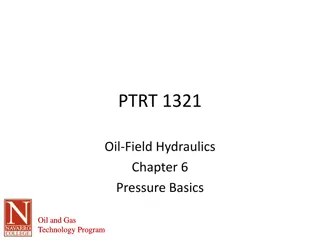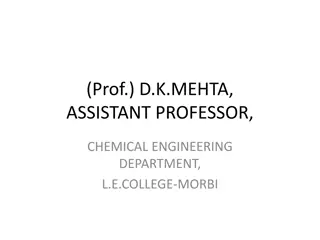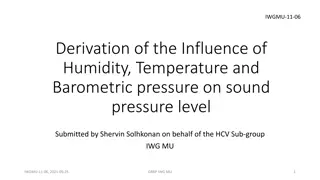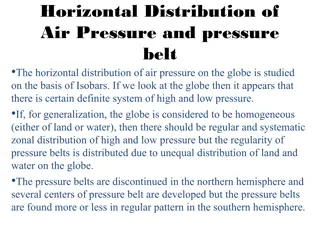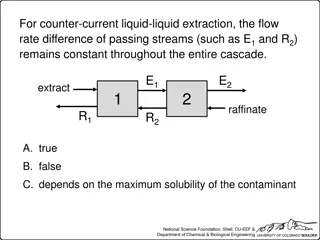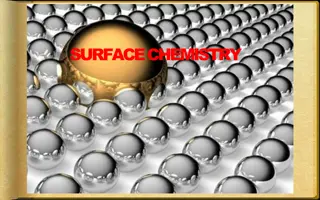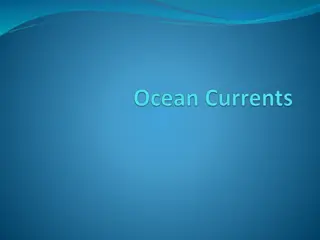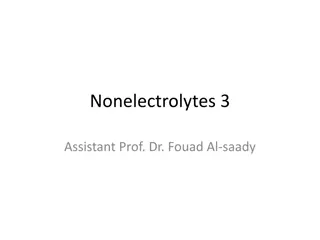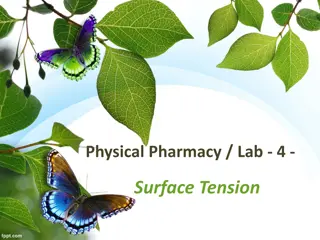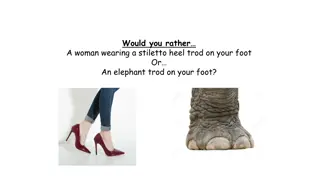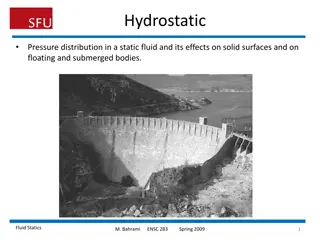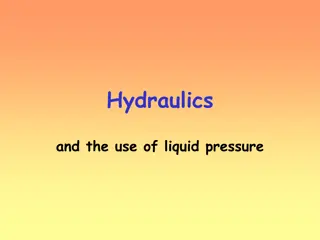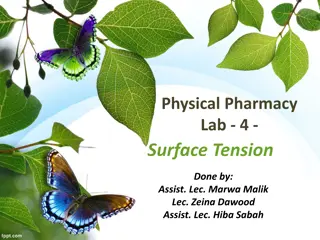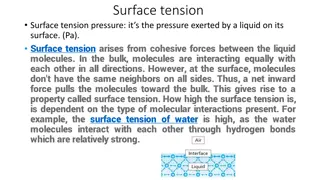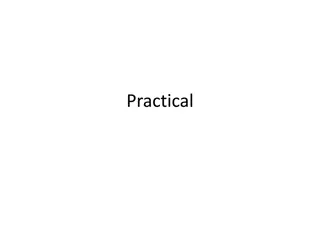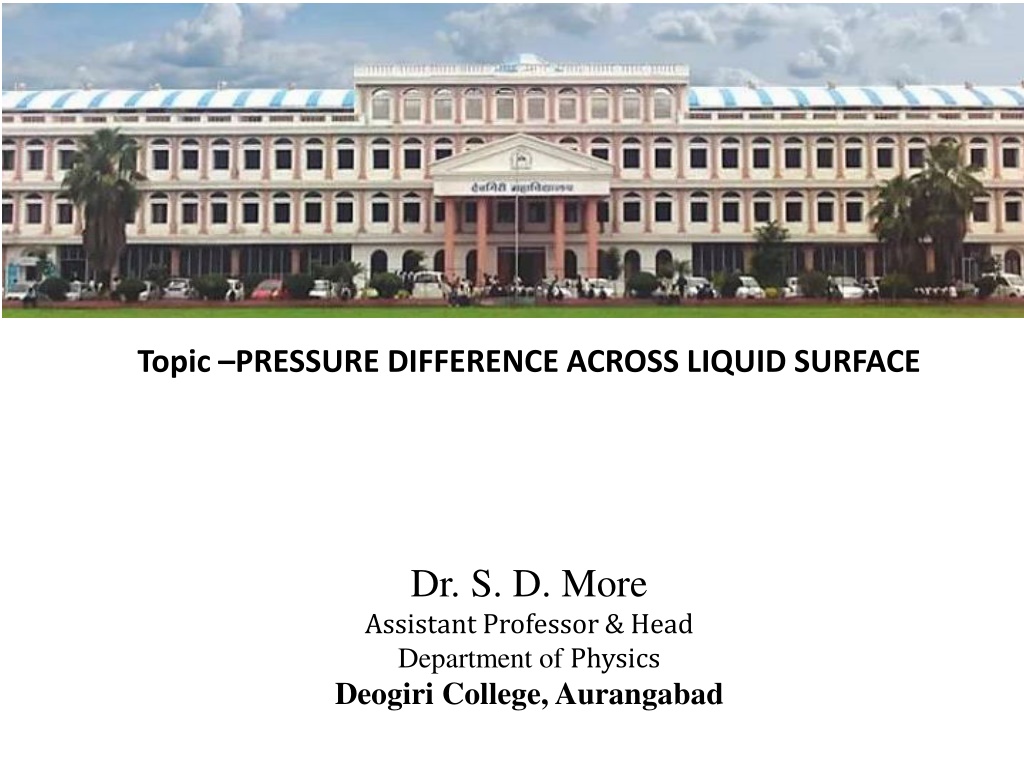
Understanding Pressure Difference Across Liquid Surfaces
Explore the concept of pressure difference across liquid surfaces as presented by Dr. S. D. More, Assistant Professor & Head of the Physics Department at Deogiri College, Aurangabad. The content covers scenarios of plane, concave, and convex liquid surfaces, detailing the resultant forces and cohesion pressures involved. Additionally, it delves into the pressure variance across curved surfaces, offering insights into the calculations and relationships involved.
Uploaded on | 0 Views
Download Presentation

Please find below an Image/Link to download the presentation.
The content on the website is provided AS IS for your information and personal use only. It may not be sold, licensed, or shared on other websites without obtaining consent from the author. Download presentation by click this link. If you encounter any issues during the download, it is possible that the publisher has removed the file from their server.
E N D
Presentation Transcript
Topic PRESSURE DIFFERENCE ACROSS LIQUID SURFACE Presented by Dr. S. D. More Assistant Professor & Head Department of Physics Deogiri College, Aurangabad
PRESSURE DIFFERENCE ACROSS LIQUID SURFACE Figure (1) If the free surface of liquid is plane as shown in Fig.(a) The resultant force due to surface tension on a molecule on its surface is zero and the cohesion pressure is negligible.
(2) If the free surface of liquid is concave [Fig.(b)] then the resultant force on a molecule on its surface would be upwards and cohesion pressure is decreased. (3) If the free surface of liquid is conves [Fig.(c)] then the resultant force due to surface tension will be directed downwards and cohesion pressure is increased
DIFFERENCE OF PRESSURE ACROSS CURVED SURFACE Fig: Imagine a small curvilinear elemnets ABCD of a liquid surface at rest.
The prssure inside it is greater than the pressure outside it. Let this excess pressure inside over the pressure outside be P . Let the length of adjacent sides AB and BC be x and y respectively. Let radii of curvature be r1 and r2 and their curvature be O1 and O2 respectively. Let surface area of curvilinear element ABCD be xy. The outward force on it is due to excess pressure (P) = Pxy Due to this force the element is displaced parallel to itself through a small distance Z into the position A B C D with center of curvature remaining unchanged.
Workdone= Pxy Z ....(1) Let sides A B = x+ x and sides C D = y+ y The new area A B C D =(x+ x) (y+ y) ....(2) Increase in surface area of the element=(x+ x) (y+ y)- xy = xy + x y + y x + x y xy = x y + y x + x y As x yis very small = x y + y x ....(3) Increase in surface energy = T(x y + y x) But, The workdone = Increase in surface energy P x y Z = T(x y + y x)
x y y x = + P T x y x y z z 1 1 y x = + P T ...(4) y x z z A' Similar to B' AB, consider We A' B' O and ABO similar tr two as iangles 1 1 A' B B' O = 1 AB + BO 1 + x r x z = i.e. 1 x r 1 z x + = + 1 1 x r 1
x z = x r 1 1 1 x = ...(5) x r z 1 Similarly considerin similar tr two g aingles B' C' O and BCO 2 2 BC' C' O = 2 BC + C O 2 + y r y z = i.e. 2 y r 2 y z + = + 1 1 y r 2
y z = y r 2 1 1 y = ...(6) y r z 2 Substituti values ng fron equation(5 equation in (6) and ) (4), We get, 1 1 = + P T r r 1 2
Different cases of film 1) Soap bubble or spherical film There are two free surface for soap bubble, so the excess pressure inside it is given by, 2 1 r r However for spherical surface r1= r2= r 2 2T r r 1 1 = + P 2T 1 1 = + = P 2T r 4T = P r
2) Solid cylinder film For cylindrical film, the radius of one surface is and radius of other surface is r. 1 1 = + P T r T = P r 3) Hollow cylinder film As hollow cylindrical film has two free surfaces, so its excess presurre is given by, 2T P = r
Determination of Surface Tension by Jagers Method: Experimental Set up - Fig
As shown in fig a funnel with control knob is inserted in bottle. The bottom end of funnel tube is closer to lower end of bottle. Another L shapped tube is inserted in the same bottle, with its one end closer to the cork of bottle. One end of this L shaped tube is connected to T shaped tube. Lower end of T tube is connected to manometer. The last end of this L shaped tube is connected to the vertical capillary tube. This capillary tube is deeped in the experimental liquid kept in a a beaker having surface tension T.
Let manometer is filled with liquid having density 2 and density of liquid kept in beaker is 1. Let the lower end of capillary tube be at a distance hl form liquid surface palced in a beaker. Working: The knob is flowly opened such that water fall it desend drop by drop in bottle. Since the bottle is air tight pressure inside increases. Due to this height difference is produced in two of liquid inside manometer. Let the height difference be hm. At the same moment bubble is produced at the lower end of the capillary tube.At this time, the pressure inside capillary tube is given by,
Po+hm2g ...(1) Where, Po - atomospheric pressure. hm - height difference of liquid in manometer 2 - density of liquid in manometer. g - acceleration due to gravity. and the pressure inside air bubble is given by, 2T 1 o l + + P h g ...(2) r Where, At equilibrium both pressure are balanced. T- surface tension of experimental liquid hl - height of tube inside liquid 1- density of experimental liquid
We have 2T + = + + P h m g P h l g 1 o 2 o r 2T = h ( g m h l ) 2 1 r rg = T (h m h l ) 2 1 2 In this way surface tension of given liquid found be can out.

